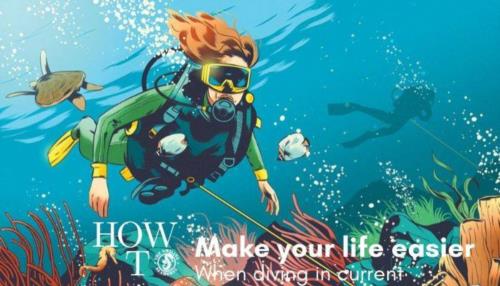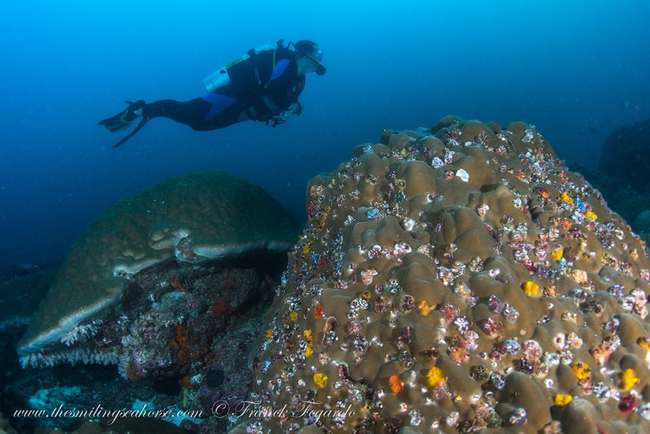
Most of the best dives are in a location where you are likely to meet strong currents. Take as example our beautiful Mergui Archipelago: currents bring nutrients and therefore lots of underwater life. But, it can be tricky to navigate, especially if you can’t drift with it because the underwater topography doesn’t allow it. Below you will find a few tips to make your immersion more comfortable and safe!
1) CHECK THE CURRENT FROM THE SURFACE
If there are any marker buoys at the surface, have a look at them. Usually if there is some current you will see it splitting at the marker level. It will give an indication of the direction and the speed.
Check the tide timetable, it could give you indications of whether the tide is going down (you have more chance to have a North to South current), or up (South to North current). Currents are weakest when its at its highest or lowest point so depending on the dive site you want to explore, this can be a great time to dive.
Ask the diving professionals or the captain of the boat. They might know how to read the water movement from the surface and can even give you tips to be able to understand it yourself.
2) USE AN APPROPRIATE ENTRY / DESCENT
Depending where you want to dive, you will have to chose the best and safest entry.
if you can find shelter at the surface: (a rock or island rising out of the water)
If you are diving from a big boat, it might be easier for the dive group to jump into a dinghy. This can allow you to get as close as possible to the entry point where you can be protected from a strong surface current which could make you drift away from the dive site before descending. Thereby, especially for beginners, you can still go into the water positively buoyant and take your time to go descend slowly.
If you dive a pinnacle (underwater mountain) :
From a big boat or a dinghy, the best way to enter will be with a negative entry (with no air in your BCD). You will not be affected by the surface current and will be able to go straight down and meet the group at the bottom.
3) BE STREAMLINED
If you have to swim against the current, you have to maintain a horizontal position in order to reduce water resistance. Proper weighting is the key of being streamlined!
Moreover, make sure all your equipment is streamlined. Any alternate air source hose, torch or pointer dangling off your gear can get stuck in the reef or make your movements more difficult.
If you are photographer, diving into current with very big cameras can be tricky. If you have the option to take a smaller device for strong current dives, don’t hesitate!
If you find yourself out of breath or too tired to kick against the current, stay close to the bottom and find a piece of rock or dead coral to rest. You can also pull yourself with one or two fingers to help you reach the point of interest. Obviously do this while staying respectful to the environment; Don’t touch anything alive, and limit contact as much as possible.
4) WATCH THE FISH!
Watching how this fish move can give you an idea of how to deal with the current.
For example, if you see a fish close to a rock staying still, you would want to seek shelter in the same place if you want to rest.
If you see a fish swimming in a vertical head up position along a wall or a slope, you understand that you will have to face a down current; don’t panic and adjust your buoyancy.
Schools of barracuda or trevally hunt swimming against the current so seeing this behaviour can give you an indication of current direction. You can also observe how strong they are swimming to have an idea of the strength of the current.
5) ALWAYS THINK ABOUT SAFETY FIRST
- You will use more gas fighting the current, so check your air gauge more often.
- You might have to stay in deep areas to find shelter or to observe the underwater life revolving around you. Be careful to watch your No Decompression Limit closely!
- If you get caught in an uncontrollable current and have to end the dive, deploy your Surface Marker Buoy as soon as possible so the captain can follow you from the surface during your safety stop. It will avoid surfacing far away from the boat and long swims.
- Dive with a professional or experienced diver who can give you advice on your technique and guide you around the dive site safely.
- If you don’t feel comfortable, end the dive! Your well-being is the most important thing to consider.

SEE ALL OUR MOST POPULAR BLOGPOST